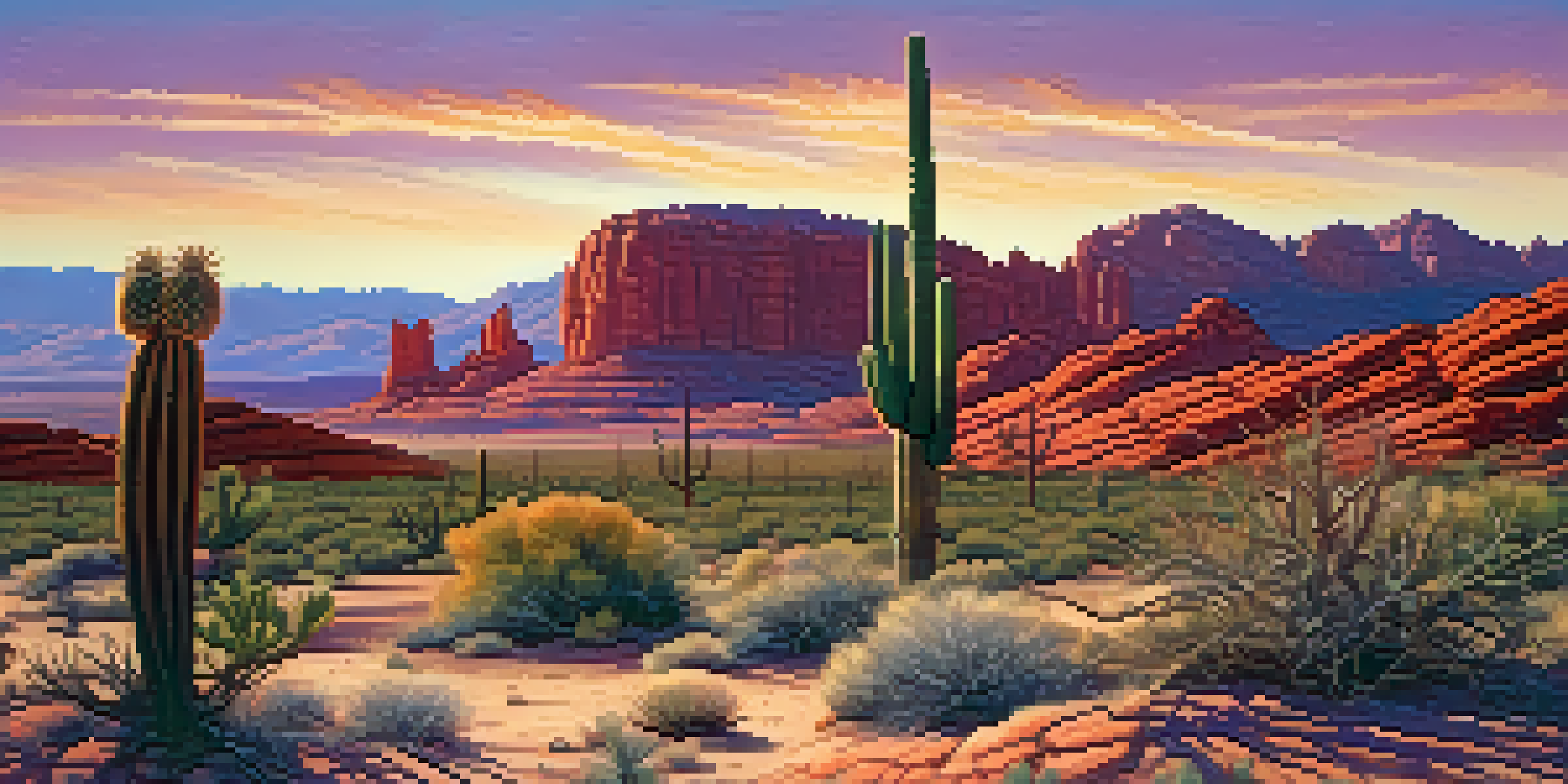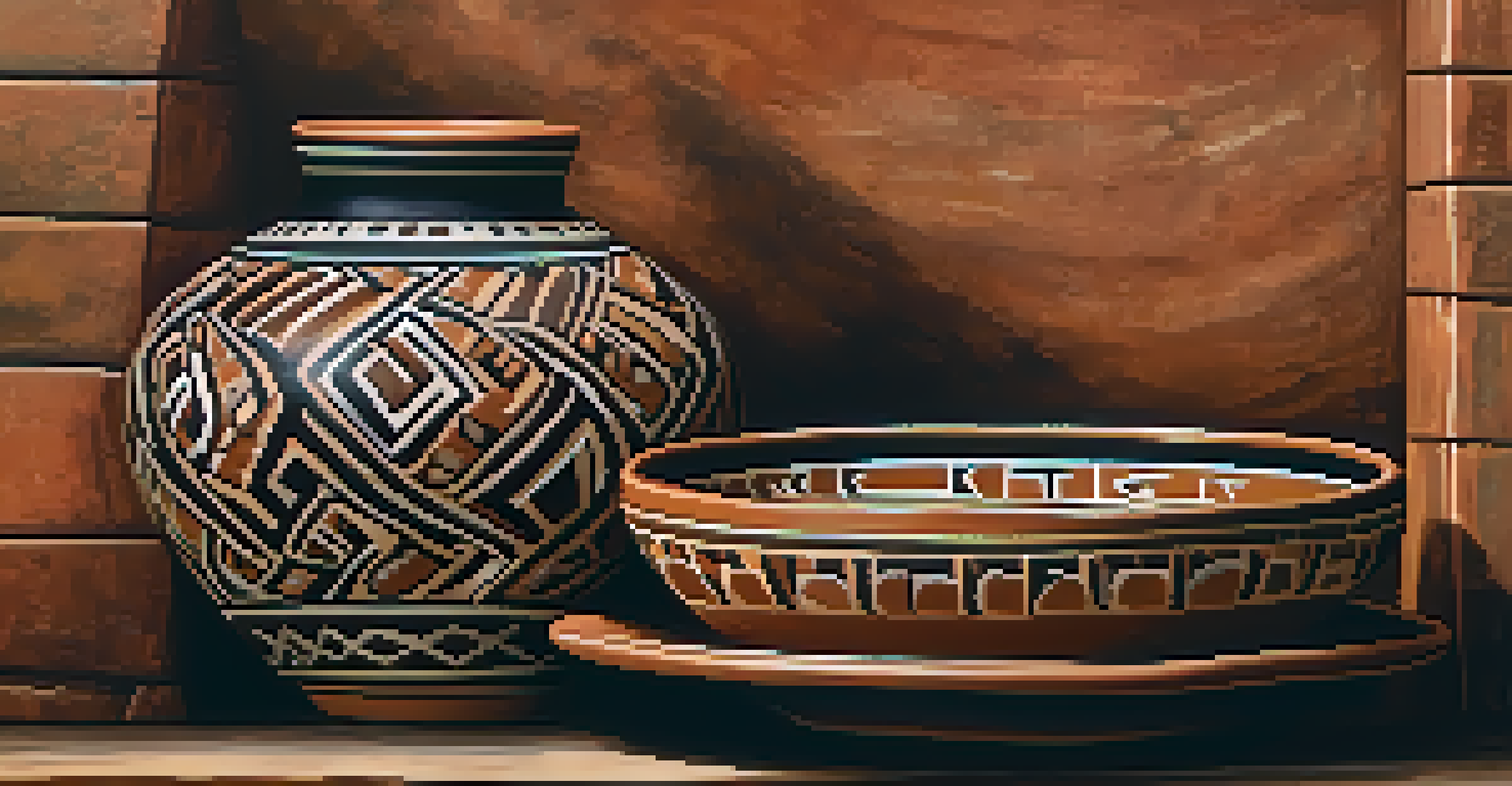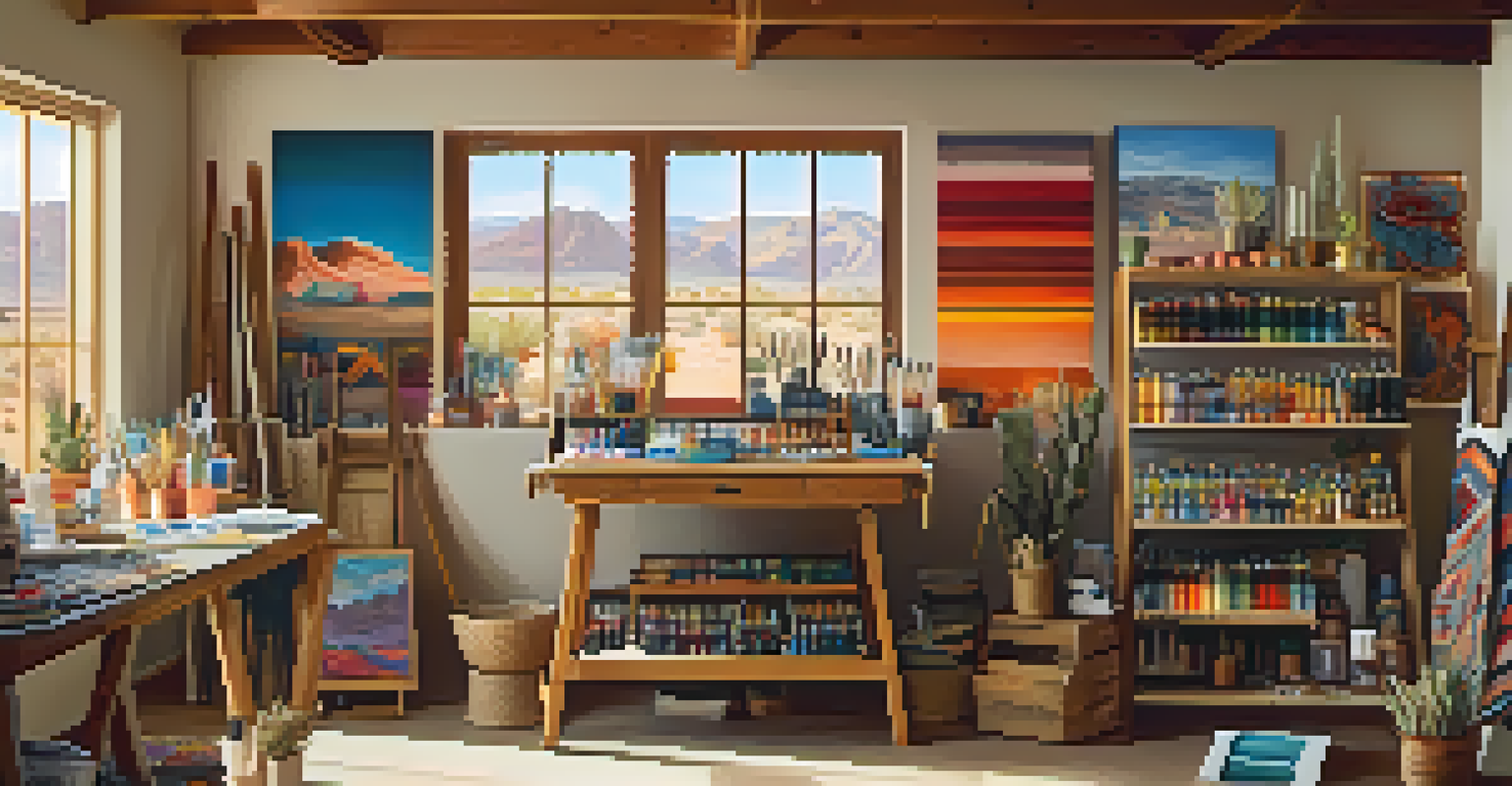The Impact of Southwestern Art on Arizona's Artists Today

Understanding Southwestern Art and Its Roots
Southwestern art is a vibrant tapestry woven from the rich cultures of Indigenous peoples, settlers, and the natural landscapes of the region. Its roots can be traced back to ancient Puebloan pottery and Navajo weaving, showcasing a deep connection to the land. This art form is characterized by its bold colors, intricate patterns, and themes reflecting nature and spirituality, all of which resonate deeply with Arizona's contemporary artists.
Art is not what you see, but what you make others see.
Today's Arizona artists draw inspiration from these traditional practices, infusing their own unique perspectives into their work. For instance, a modern painter might incorporate the vivid colors of a desert sunset into their canvas, echoing the hues found in traditional Southwestern textiles. These connections to the past create a continuity that enriches the artistic landscape of Arizona.
Moreover, understanding the historical context of Southwestern art allows artists to honor their predecessors while innovating new styles and techniques. This blend of respect for tradition and the drive for personal expression is what keeps Arizona's art scene dynamic and relevant.
Cultural Fusion in Arizona's Art Scene
Arizona's artistic landscape is marked by a unique blend of cultures, where Southwestern art serves as a foundational element. Artists from various backgrounds incorporate traditional motifs into their work, creating a fusion that celebrates diversity. This cultural cross-pollination not only enriches individual artistic expressions but also fosters a sense of community among artists.

For example, a Hispanic artist might combine elements of Mexican folk art with Indigenous patterns, resulting in pieces that reflect both heritages. This kind of cultural dialogue encourages collaboration and experimentation, as artists learn from one another and share techniques. Such collaborations often lead to exhibitions that showcase this beautiful melding of styles.
Cultural Fusion Enriches Southwestern Art
Arizona's art scene thrives on the blend of various cultural influences, creating a diverse and collaborative artistic community.
As a result, the art produced in Arizona is not only visually stunning but also tells a story of its multifaceted identity. This cultural fusion allows artists to connect with a broader audience, making their works resonate on multiple levels.
The Role of Nature in Southwestern Artistic Expression
Nature plays an integral role in Southwestern art, serving as both muse and medium for many Arizona artists. The state's breathtaking landscapes, from the red rocks of Sedona to the expansive deserts, inspire countless artistic creations. Many artists find that the natural world informs their work, encouraging them to convey the beauty and complexity of their surroundings.
The job of the artist is always to deepen the mystery.
For instance, a sculptor might use local materials like sandstone or clay, creating pieces that feel intrinsically tied to the Arizona landscape. Similarly, photographers often capture the ethereal light and dramatic skies that define the region, producing works that evoke a sense of place. This emphasis on nature not only honors the environment but also invites viewers to appreciate the world around them.
In this way, Southwestern art becomes a dialogue between the artist and the landscape, resulting in pieces that reflect both personal and universal experiences. This connection to nature reinforces the importance of environmental stewardship, a value that many contemporary artists advocate for through their work.
Influence of Native American Culture on Modern Artists
Native American culture has a profound influence on many of Arizona's contemporary artists, who often draw from traditional techniques and stories. This cultural heritage inspires artists to explore themes such as identity, spirituality, and community, creating works that resonate with both Indigenous and non-Indigenous audiences. By weaving these elements into their art, they help to keep these traditions alive and relevant.
For example, a ceramic artist might use ancient Puebloan methods to create modern pieces that tell stories of her ancestry. This blending of old and new not only showcases her heritage but also engages viewers in a conversation about cultural preservation. As a result, these artists play a crucial role in educating the public about the richness of Native American history and its ongoing relevance.
Nature Inspires Artistic Expression
The stunning landscapes of Arizona serve as a muse for artists, encouraging them to incorporate the beauty of their surroundings into their work.
Moreover, this influence encourages a greater appreciation for Indigenous perspectives and fosters dialogue about cultural appropriation and respect. By honoring these traditions, contemporary artists contribute to a more inclusive and understanding art community.
Economic Impact of Southwestern Art on Local Artists
The Southwestern art scene significantly contributes to Arizona's economy, providing artists with opportunities to thrive. Galleries, art festivals, and markets showcase local talent, drawing tourists and collectors alike. This influx of visitors not only supports artists financially but also elevates Arizona as a cultural destination, further amplifying the reach of Southwestern art.
For instance, events like the Santa Fe Indian Market attract thousands of visitors, allowing artists to sell their work and gain visibility. Such platforms enable artists to build their brand and establish a loyal customer base. Additionally, the economic support helps sustain traditional art forms and encourages new generations of artists to pursue their passions.
Ultimately, the economic vitality created by Southwestern art fosters a thriving community where artists can collaborate, innovate, and share their stories. This interconnectedness strengthens Arizona's cultural fabric, making it a vibrant hub for creativity.
New Media and Technology in Southwestern Art
With the advent of technology, Arizona's artists are exploring new media that expands the boundaries of Southwestern art. Digital tools allow for innovative expressions, from virtual reality experiences to digital paintings that incorporate traditional motifs. This fusion of technology and tradition opens up exciting possibilities for storytelling and artistic exploration.
For example, an artist might create an interactive installation that invites viewers to engage with the themes of Southwestern culture in a dynamic way. This blend of the old and new not only captivates audiences but also challenges perceptions of what art can be. As artists embrace these technologies, they find new ways to connect with their audience and convey their messages.
Preservation of Artistic Heritage
Contemporary artists emphasize the importance of preserving traditional Southwestern art forms while engaging younger generations through mentorship and education.
Moreover, the internet has enabled artists to reach global audiences, sharing their work beyond local galleries. This digital platform empowers them to showcase their creations and engage with art enthusiasts around the world, creating a sense of community that transcends geographical boundaries.
Preserving Southwestern Art for Future Generations
Preserving Southwestern art and its cultural significance is crucial for future generations. As contemporary artists innovate and reinterpret traditional forms, they also recognize the importance of maintaining the integrity of these art forms. Many artists actively engage in mentorship and educational programs that teach younger generations about their cultural heritage.
For instance, workshops that focus on traditional techniques in pottery or weaving help to pass down valuable skills and knowledge. These initiatives not only empower young artists but also foster a sense of pride in their cultural identity. By emphasizing the importance of preservation, artists ensure that the stories and traditions of the past continue to thrive.

In addition, collaborations between artists and cultural institutions play a vital role in safeguarding this heritage. Exhibitions and community events that celebrate Southwestern art create awareness and appreciation, ensuring that these traditions are cherished and respected. This commitment to preservation helps to ensure that the vibrant legacy of Southwestern art remains alive for generations to come.